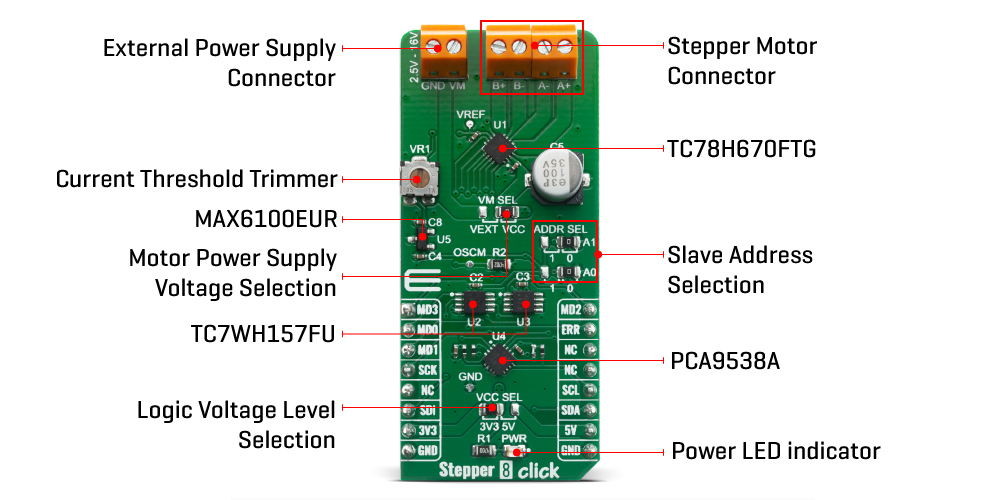


Overview
The Stepper 8 Click Board™ is a motor control add on board based on TC78H670FT from Toshiba. A clock-in and serial controlled Bipolar Stepping Motor Driver which can drive a 128 micro-stepping motor with a power supply ranging from 2.5V to 16V for a wide range of applications include USB-powered, battery-powered, and standard 9-12V system devices. A perfect solution for driving stepper motors in security cameras, portable printers, handheld scanners, pico-projectors, smartphones and many more.
Downloads
How Does The Stepper 8 Click Board™ Work?
The Stepper 8 Click Board™ can be used with bipolar step motor, coils should be connected to the onboard screw terminals. There are two terminals, used to connect each of the step motor coils. The third connector is used to connect an external voltage, ranging from 2.5V to 16V, depending on the used motor voltage requirements and current of 2A. The maximum output current may be further limited in view of thermal considerations, depending on ambient temperature and board conditions. It should be noted that without a valid external voltage connected to this terminal, the motor will not work.

The Stepper 8 Click Board™ can operate a bipolar stepper motor in full, half, quarter, 1/8, 1/16, 1/32, 1/64, 1/128 step operation. Thanks to internal safety features, such as thermal shutdown (TSD), over current (ISD), motor load open (OPD) and under voltage lockout(UVLO), this Click board™ is perfectly suited for rapid development of various stepper motor applications.
This TC78H670FTG integrated driver offers a simple interface, featuring a set of pins used to control the functions of the step motor. Since the number of pins exceeds the available mikroBUS™ general purpose pins, an additional port expander IC is used, exposing a 2-wire I2C interface for the communication with the host MCU. The port expander IC is the PCA9538, an 8-bit port expander with the I2C interface.
The MODE0-3 pins can be selected Serial mode or CLK-IN mode. The control mode is set up by the input state of the MODE0-3 pins after releasing standby mode. Under the serial mode, it performs setting and motor control in the following 32 bit format using SPI on mikroBUS™. For the motor control, each current value is set in the serial setting, and the output is updated to the set current value at the timing of the LATCH signal. More information about using Serial mode or CLK-IN mode can be find in TC78H670FTG datasheet.
To allow both Serial mode or CLK-IN mode on mikroBUS™ a TC7WH157 two channel multiplexer from Toshiba is used. Selection is done using I2C communication with PCA9538 port expander and changing state of SELECT pins on multiplexers.
SPECIFICATIONS
| Type | Stepper |
| Applications | The Stepper 8 Click Board™ is suitable for Security cameras, portable printers, handheld scanners, pico-projectors, smartphones and many more |
| On-board modules | TC78H670FTG |
| Key Features | Advanced Current Detection System, Built-in Dual H Bridges, Low on-resistance, Multi error detect functions |
| Interface | GPIO,I2C,SPI |
| Compatibility | mikroBUS |
| Click board size | L (57.15 x 25.4 mm) |
| Input Voltage | 3.3V or 5V |
PINOUT DIAGRAM
This table shows how the pinout on the Stepper 8 Click Board™ corresponds to the pinout on the mikroBUS™ socket (the latter shown in the two middle columns).
| Notes | Pin |  |
Pin | Notes | |||
|---|---|---|---|---|---|---|---|
| MODE3 | MD3 | 1 | AN | PWM | 16 | MD2 | MODE2 |
| MODE0 | MD0 | 2 | RST | INT | 15 | ERR | Enable/Error |
| MODE1 | MD1 | 3 | CS | RX | 14 | NC | |
| SPI Clock | SCK | 4 | SCK | TX | 13 | NC | |
| NC | 5 | MISO | SCL | 12 | SCL | I2C Clock | |
| SPI Data IN | SDI | 6 | MOSI | SDA | 11 | SDA | I2C Data |
| Power Supply | 3.3V | 7 | 3.3V | 5V | 10 | 5V | Power Supply |
| Ground | GND | 8 | GND | GND | 9 | GND | Ground |
ONBOARD SETTINGS AND INDICATORS
| Label | Name | Default | Description |
|---|---|---|---|
| LD1 | PWR | - | Power LED Indicator |
| JP2 | VCC SEL | Left | Logic level voltage selection: left position 3V3, right position 5V |
| JP1 | VM | Right | Power supply selection: left position - External supply, right position - On-board supply |
| JP3, JP4 | ADDR SEL | Right | Slave address selection: left position 1, right position 0 |
| VR1 | VR1 | - | Current threshold reference adjustment trimmer |
STEPPER 8 CLICK ELECTRICAL SPECIFICATIONS
| Description | Min | Typ | Max | Unit |
|---|---|---|---|---|
| Supply Voltage | 2.5 | - | 16 | V |
| Output Current | 0 | - | 2 | A |
| fOSCM | 656 | 1266 | 3290 | kHz |
| fchop | 41 | 79 | 206 | kHz |
| General Information | |
|---|---|
Part Number (SKU) |
MIKROE-4157
|
Manufacturer |
|
| Physical and Mechanical | |
Weight |
0.022 kg
|
| Other | |
Country of Origin |
|
HS Code Customs Tariff code
|
|
EAN |
8606018717606
|
Warranty |
|
Frequently Asked Questions
Have a Question?
Be the first to ask a question about this.



